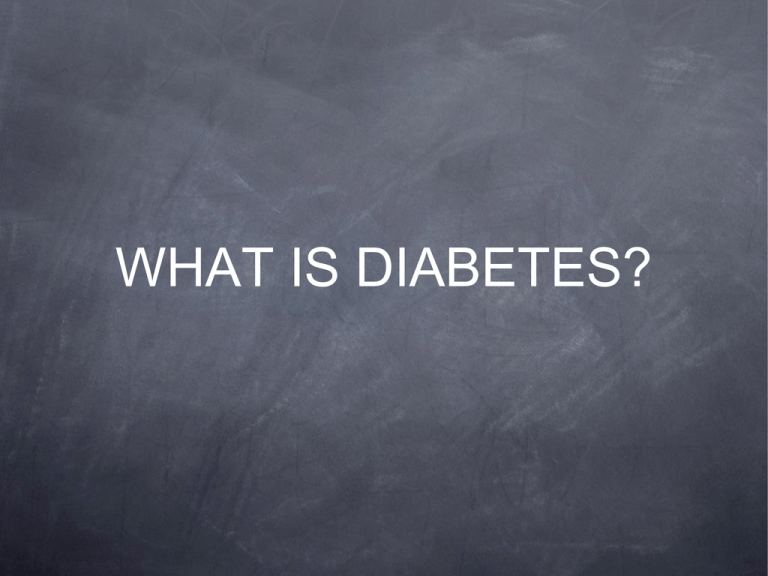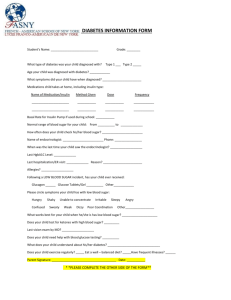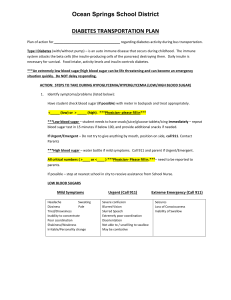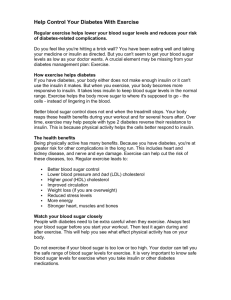WHAT IS DIABETES?
advertisement

WHAT IS DIABETES? DIABETES Diabetes is a chronic condition for which there is no cure The body does not make or properly use insulin, a hormone needed to convert food into energy (glucose). Insulin serves two purposes - it unlocks cells to allow blood glucose to enter AND it turns off the production of excess glucose produced by the liver TWO TYPES OF DIABETES Type I - an auto-immune disease; beta cells of the pancreas are damaged and do not produce insulin or not enough insulin Type II - the body is unable to use the insulin produced; insulin is not able to unlock the cells to allow the blood sugar to enter and be used for energy. Over time insulin production may stop. IF YOU HAVE DIABETES blood sugar builds up in the bloodstream (hyperglycemia) and ultimately some of it gets secreted into the urine and the body loses its energy source Untreated levels of blood sugar can damage blood vessels, eyes, kidneys, nerves and lead to serious health complications DIABETES The result in both Type I and Type II is high levels of blood sugar (hyperglycemia)causing increased thirst and urination, hunger, fatigue, weight loss, nausea, and blurred vision DIABETES Treatment involves a balance of diet, exercise, and medication Insulin is used to treat hyperglycemia in Type I and some Type II diabetics Effective Management is crucial for the safety of the student for the long-term health of the student to ensure the student is ready to learn and fully participate to avoid a medical emergency TWO COMPLICATIONS OF DIABETES HYPERGLYCEMIA - high blood sugar HYPOGLYCEMIA - low blood sugar HYPOGLYCEMIA Hypoglycemia (low blood sugar) is the most urgent and most frequent complication of diabetes Blood sugar can drop as a result of not enough food, too much insulin, too much exercise or any combination Hypoglycemia symptoms may include feeling shaky, sweaty, hungry, tired, dizzy, confused, weak, headache, irritable if not treated immediately, can lead to more severe symptoms of unconsciousness and seizures HYPOGLYCEMIA • A student should NEVER BE LEFT ALONE if he/she FEELS HIS/HER BLOOD SUGAR IS LOW • have the student escorted to the nurse’s office Treatment for Hypoglycemia if blood sugar is below 70 or if student feels his/her blood sugar is low give a fast acting sugar such as, 4 glucose tabs, 4 ounces of juice or regular soda, 7 life savers, 15 Skittles, 10 sweet tarts, 4 tsp. sugar NOT chocolate or a candy bar have student escorted to the nurse’s office BASIC CARE AT SCHOOL Goal - is to maintain a target blood sugar generally 80-120 This is accomplished by regular blood sugar monitoring and giving assistance in an emergency BASIC CARE AT SCHOOL follow the student’s IEP, 504, Emergency Plan allow student to check blood sugar before lunch, before activity, before dismissal, and anytime the student feels the need allow the student to go to the nurse as needed allow snack and water as needed allow to use bathroom as needed HYPERGLYCEMIA is the result of too much food, too little insulin, or too little exercise the body is under stress such as illness this is less of a concern in school as complications from it are not immediate symptoms include extreme thirst, frequent urination, drowsiness, nausea HYPERGLYCEMIA treatment is a dose of insulin sugar free fluids can also be helpful if insulin is not available or it is too soon for another dose of insulin NO NEED TO PANIC diabetics usually can feel when their blood sugar is high or low generally, the student will tell you when he/she needs to check his/her blood sugar If a student feels his/her blood sugar is low, offer/suggest a fast acting sugar and send to the nurse with a buddy DIABETES WORKING TOGETHER WILL ENSURE THE SAFETY AND SUCCESS FOR OUR DIABETIC STUDENTS






